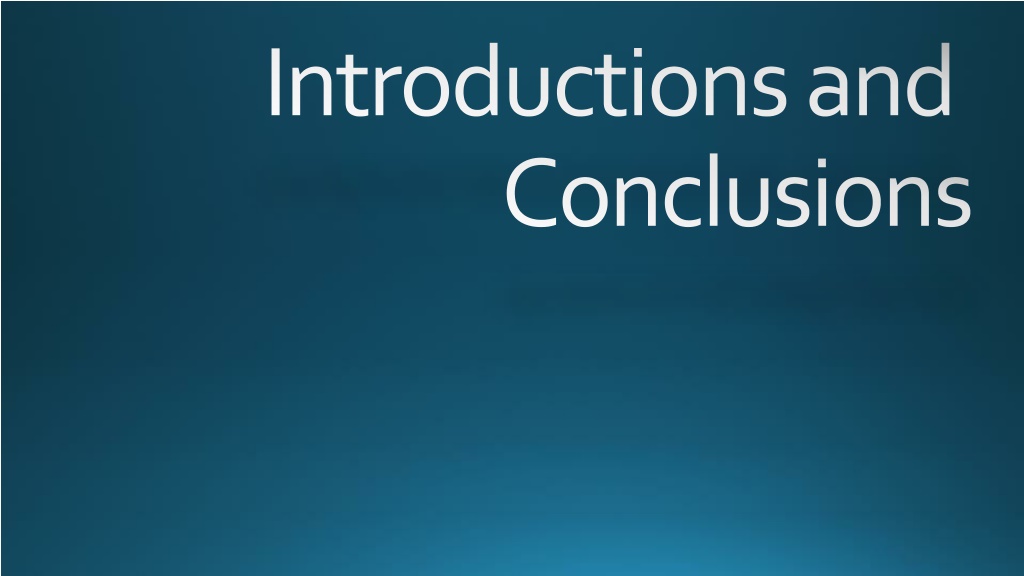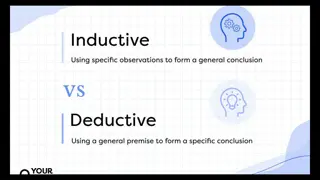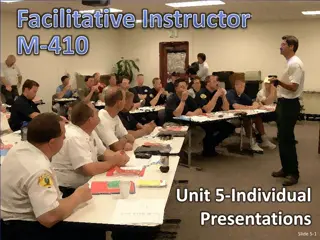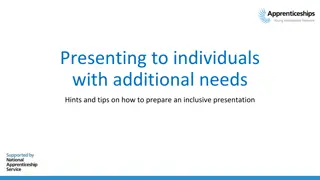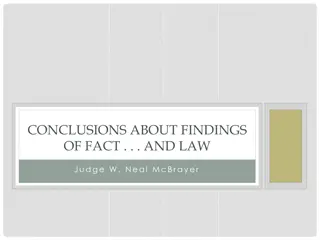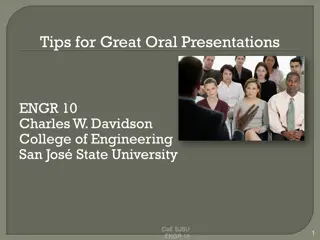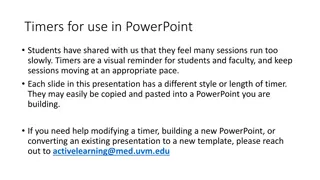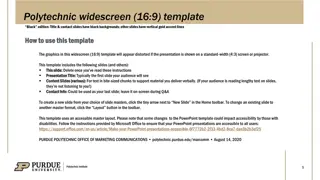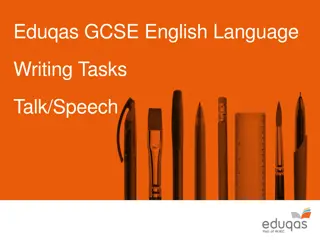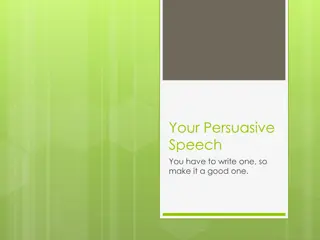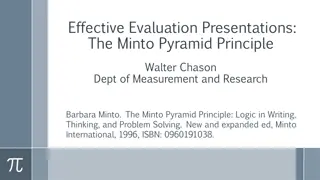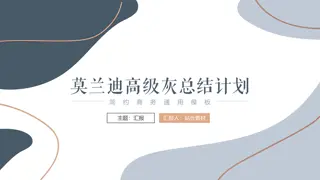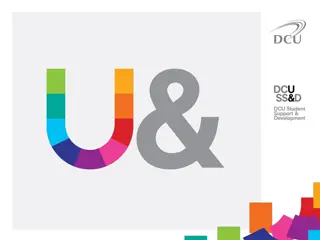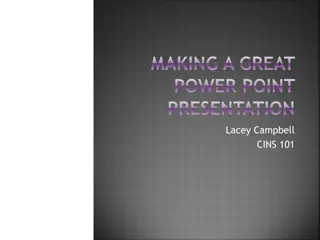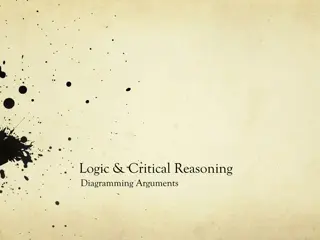Mastering Introductions and Conclusions for Engaging Presentations
Learn the essential elements of crafting powerful introductions and conclusions for your presentations. Explore strategies to captivate your audience, establish credibility, and leave a lasting impact. Discover techniques such as using rhetorical questions, impactful quotations, and startling facts to grab attention and keep your audience engaged throughout your speech.
Download Presentation

Please find below an Image/Link to download the presentation.
The content on the website is provided AS IS for your information and personal use only. It may not be sold, licensed, or shared on other websites without obtaining consent from the author. Download presentation by click this link. If you encounter any issues during the download, it is possible that the publisher has removed the file from their server.
E N D
Presentation Transcript
Introductions and Conclusions
Audience Memory Curve MOST LEAST BEGINNING END
Goals of an Introduction 1 Grab attention Motivate audience to listen 2 Establish credibility and rapport 3 Present thesis statement 4 5 Agenda
Be Great Fast - Hooking the audience
Rhetorical Designed to make the audience think Why is it important to care about the environment? Why is Apple so innovative? How often do you notice students looking at their phones during class? Do you think we have enough healthy lunch options at our school? Do pigs fly? Actual Active audience participations; solicit a response I would like a show of hands on this question:: How many people have travelled abroad? Grab Attention: Questions 1
Mahatma Gandhi, the great Indian leader, once said, There are seven things that will destroy us: wealth without work; pleasure without conscience; knowledge without character; religion without sacrifice; politics without principle; science without humanity; business without ethics. Grab Attention: Quotations More effective when the audience is familiar with the source When asked how long I ve worked here, I replied, Since the day they threatened to fire me. --Anonymous A business that makes nothing but money is a poor business. -- Henry Ford The man who moves a mountain begins by carrying away small stones. Confucius
Grab Attention: The average person spends 5 years waiting in line 1 in 3 men don t wash their hands after using the bathroom 43% of pilots admit to falling asleep during a flight Recycling a single days worth of the New York Times could save 75,000 trees or more. Startling Factsor Statements
Factual or hypothetical story Grab Attention: Imagine that it s a school day and your alarm has just gone off. You reach over and after several tries finally get that awful noise to quit. You pull the cover from your head, force your eyes open, yawn, and roll over. You re thinking, Should I get up and go to class, or should I skip the class and sleep in a bit longer? After all, the weather is bad today and I do have a cold . . . . Instance Detailed Narrative (Anecdote or Story)
Grab Attention: Humor Demonstration Definition or explanation Fables, sayings, poems, rhymes Other options
Motivate audience to listen Even if they like your opening, doesn t guarantee they will continue to listen Need to tell that there is an advantage for them WIIFM --What s in it for me? Why should I care? Consider your audience analysis Demographics, psychographics (motivations) 2
Needs that motivate listeners Motivate audience to listen Reduce stress and anxiety Earn more money Gain personal satisfaction Impress others and gain esteem Develop self-confidence Try something new and exciting Solve a pressing problem Achieve desired goals with less effort Increase prestige or power Advance rank/position with a new skill Gain a feeling of pride in a job Reach more customers 2 Ensure job stability and security Look more attractive Become healthier Improve parenting skills Help others Make a difference in the world
Believability and feeling of liking and respect Share your expertise with the audience Personal experience Work or professional experience I have led the innovation team here for 10 years Mention why topic is important to you Cite expert sources you consulted Show gender and cultural sensitivity Establish a common ground shared experience or motivation Establish Credibility 3
Statement of proposition or position (see Persuasion ppt Jennie Hansen (2010), speaking to primary care providers about patient safety Present Thesis Statement as a career health care professional, I hold the view that systemic and individual change [in patient safety] has, and will be, far more productive in reducing medical errors than will pointing the finger of blame, or targeting individual providers 4
Preview of your main points Agenda Today I will discuss 1 2 3 Problem 5 Solution Benefits
Summarize central idea and main points End with a memorable, refocusing thought that relates back to the introduction End with a positive, vivid picture Tell audience exactly what to do Goals of Conclusion Do NOT present any new information
CREATING AN EFFECTIVE ARGUMENT Claim Position statement; a conclusion you want your audience to reach Evidence Supports the claim with materials such as examples, statistics, expert opinions Warrant Justifies the evidence and shows how it supports the claim
Claim: Using a cell phone increases the likelihood that you will be involved in an accident. Evidence A. In 2001, cell phone use was a factor in 1,032 accidents and eight fatalities in Texas alone. B. Regardless of the age or the driving experience of the driver, the risk of being in a collision when using a cell phone is four times higher than when not talking on the phone. Warrant The 2001 statistics were reported by Susan Dunn in a 2004 article in USA Today.
SUPPORTING MATERIAL Visual: used to clarify and add interest to your speech idea Verbal: used to clarify, prove, and add interest to your speech idea
Clarification Clarification Clarification & Clarification & Proof Proof Explanations Hypothetical illustrations (detailed instances) Figurative comparisons Statistics Factual examples (brief instances) Factual illustrations (detailed instances) Fables, poems, rhymes, stories Expert opinions Demonstrations Literal comparisons
EXPLANATION Defines or gives more info about a topic Gives instruction on how to do something Describes how something works Describes the relationship between certain items
STATISTICS Rule 1: Make your statistics meaningful by relating them to your listeners frames of reference. Rule 2: Eliminate any statistics that are not absolutely necessary Rule 3: Whenever possible, present your statistics in graphic form Rule 4: Round off the numbers to make them easy for your listeners to recall Rule 5: Demonstrate the credibility of your statistics by citing the source, the reason the source is considered expert (if the audience doesn t already know), and the size of the population from which the statistics were compiled
Audience Recall 70 Verbal only 10 72 Visual only 20 85 Verbal and Visual 65 0 10 20 30 40 After 3 days 50 60 70 80 90 After 3 hrs
INSTANCES Actually happened Made up but could happen Hypo- thetical Factual Brief Detailed Basic facts only (example) Vivid picture or narrative (illustration)
FACTUAL EXAMPLE Usually brief; effective when using two or more CEO of Pepsi to Economic Club of Chicago We have a large portfolio of products. Eighty per cent of our portfolio is made up of products we call Fun For You or Better For You products such as Pepsi, Diet Pepsi, Mt Dew, SoBe Life Water, Propel, Lays, Doritos, Fritos, Sun Chips, Cheetos and Tostitos the world s most loved brands. The other twenty per cent is made up of products that we describe as Good For You healthy products such as Tropicana, Quaker Oats, Naked Juice and Gatorade for athletes
SPEECH ABOUT CHANGING HEALTHCARE TO MEET BABY-BOOMER EXPECTATIONS Boomers have never lost the need to be in control. They are less likely to accept the word of authority than their parents. [For example] Tell them they have to do things your way because those are the rules of the institution and they will choose another institution. Take a number and wait means they don t have control. In fact, most health care processes that devalue the patient s time and individualism run smack up against the Boomer need for control
HYPOTHETICAL ILLUSTRATION Useful to easily relate something to the audience Speech on class attendance Imagine that it s a school day and your alarm has just gone off. You reach over and after several tries finally get that awful noise to quit. You pull the cover from your head, force your eyes open, yawn, and roll over. You re thinking, Should I get up and go to class, or should I skip the class and sleep in a bit longer? After all, the weather is bad today and I do have a cold . . . .
COMPARISONS Literal comparison shows similarities or differences between two or more items in the same class or category Comparing population of two cities Figurative comparison is used for two or more items from different classes or categories For adding interest and clarity, not proof People are like snowflakes The mayor is like the captain of a ship
LITERAL COMPARISONS According to the latest Nielsen reports, the average American spends a little over 5 hours a day watching television and another hour a day surfing the Internet. On the other hand, U.S. wireless customers in 2008 use their phones an average of 26 minutes a day. Less than half an hour on the wireless side . . . more than six hours on the TV and Internet side. If we can get even a modest amount of that usage to migrate to mobile, we have lots of headroom to grow.
FIGURATIVE COMPARISON The fear of giving a speech is similar to the fear you had as a child when you first learned to ride a bike. Remember how nervous you were, waiting for your dad to put you on the bike? But as soon as you began to ride, your fear was replaced by excitement, and by the time the lesson was over, the excitement had turned to a feeling of accomplishment and of being in control. And you wondered why you had been so nervous at all. Well, speaking is much the same. Once you start speaking, nervousness turns into excitement and then into a feeling of accomplishment. You will wonder why you bothered being nervous at all.
EXPERT OPINIONS Excellent way to clarify or prove a point (1) state the name of the expert (2) briefly describe his or her qualifications (unless you are sure that your audience is familiar with the person) (3) briefly cite when and where the expert reported the information (such as in the latest issue of U.S. News and World Report or in a personal interview you conducted last week)
PARAPHRASE In his new book [Re-Imagine! Business Excellence in a Disruptive Age] Tom Peters quantifies that American women constitute are you ready? the largest economy in the world; followed by the entire nation of Japan, and then American men (Nelson, 2004, p. 339).
PARAPHRASE + PERSONAL OPNON David Lawrence, the retiring CEO of Kaiser Permanente, noted that in the $1.5 trillion that Americans spend on health care, close to $300 billion of that in his estimation is due to medical mistakes and errors in medicine, and we [the California Endowment for Unequal Healthcare Treatment] think that some significant percentage of that $300 billion is due to mistakes as a result of language services and inappropriate interpretation and medical translation in the clinical setting (Ross, 2003, p. 53)
DRECT QUOTE Tim Brown, CEO and President of the design firm IDEO, said it well in a recent Harvard Business Review essay: Edison s genius, Brown wrote, lay in his ability to conceive a fully developed marketplace, not simply a discrete device. Edison understood that the light bulb was little more than a parlor-trick without a system of electric power generation and transmission to make it truly useful. So, he created that too (Rodin, 2009, p. 262
FABLES, SAYINGS, POEMS, RHYMES Often in Intro and Conclusison; do not prove anything Fables (fictitious stories, usually with animal characters, meant to teach moral lessons) Sayings (pithy expressions of truth or wisdom) Poems (words written in meter or free verse that express ideas, experiences, and emotions in an imaginative style) Rhymes (verses that regularly repeat sounds) deserve to be used more often.
JANE GOODALL - DANGERS TO THE ENVIRONMENT: THE CHALLENGE LIES IN ALL OF US It makes me think of a fable my mother used to read to me and my sister when we were little, about the birds coming together to have a competition: who could fly the highest? The mighty eagle is sure he will win, and majestically with those great, strong wings he flies higher and higher, and gradually the other birds get tired and start drifting back to the ground. Finally, even the eagle can go no higher, but that s all right, because he looks down and sees all the other birds below him. That s what he thinks, but hiding in the feathers on his back is a little wren and she takes off and flies highest of all. The reason I love this story is because . . . if we think of our life as an effort to fly always just a little bit higher and reach a goal that s just a little bit beyond our reach, how high can any of us go by ourselves? We all need our eagle . .
SAYNGS Used to add perspectice, interest; do not prove anything It s like that old saying: Success has many parents, but failure is an orphan
DEMONSTRATION Telling about the efficiency of a vacuum cleaner could impress a client, but showing it pick up pebbles and nails works better Think of infomercials
